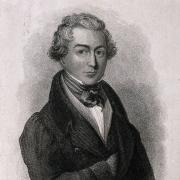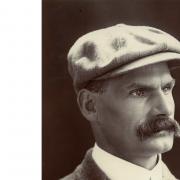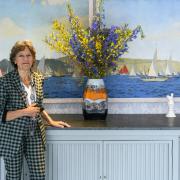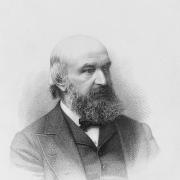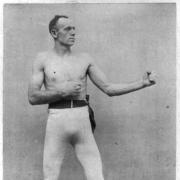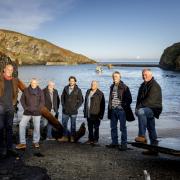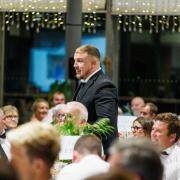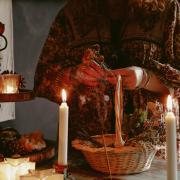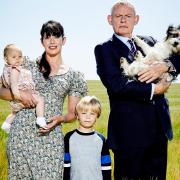Straight out of a Hollywood film, attempts to ban vulgar dancing was overthrown by the enthusiasm of the Geeze dancers, writes Merv Davey
Geeze Dancing is a very old Cornish tradition. In 1803 the historian Richard Polwhele describes the custom as 'the guise or disguise dance, for so the Cornish pronounce guise (geeze). This dance answers to the mummers of Devon, and the Morrice dancers of Oxfordshire and beyond.
In Celtic Cornish ges, means mockery, a jest. It is likely that the word is a conflation of the term 'Ges' a jest, with 'Gis' meaning fashion and the English term 'Guise' thrown in for good measure.
Geeze Dancing takes many forms but in essence it is an opportunity to dress up in bizarre costume or mock posh and be someone different. The Geeze Dancers perambulate through the streets performing a piece of “folk business” which might be a song, a dance, a play, a mock court or a wassail etc.

The tradition is seen all year round from the Spring customs of Padstow’s 'Obby Oss' and Helston’s 'Hal an Tow' to the Midsummer traditions of Bodmin’s 'Beast' and Mazey Day in Penzance. The dark months of December and January are their true, spiritual home, however, as this is when the Geeze Dance appears the most mysterious and when people particularly enjoy an escape into the world of 'the other'.
The St Ives Geeze Dancers were a well-established winter tradition in the 19th century but according to the St Ives Weekly were not always approved of. 'I learn with greatest satisfaction that the worthy Mayor of St Ives, Mr Edward Hain has prohibited Gees Dancing for the year 1900. In this I feel he has the support of every man and woman having any pretensions to moral refinement in the parish… the people parade the streets many being “dressed up”, shouting, singing, dancing, and an indulgence in a rough kind of play.
'Some masquerade as animals, some as kings and queens but what seems to create the greatest fun, and is the most enjoyed by the crowd, are men dressed as women and women dressed as men, girls as boys and boys as girls, some of whom under the influence of drink, perform sundry antics which, for vulgarity, would be hard to beat.'
The prohibition evidently failed, and the Geeze Dancers continued with their winter perambulations. In 1923 the St Ives Police Superintendent reported triumphantly that there had been only one incident during the revelry that year! The St Ives Old Cornwall Society added their enthusiasm to the event in the 1930s and it remained popular until the Second World War after which there was a period of hibernation. Enthusiasm was rekindled in the 1970s by Dave Lobb, son of one of the original Geeze Dancers and the tradition has taken different forms since then, sometimes appearing over Christmas and sometimes for St Ives Feast in February.

The St Ives Geeze Dancers retain their mystique and we do not know when or where they will appear as the year turns but worth watching out for on the streets of St Ives during the evenings leading up to Christmas.
Early nineteenth century descriptions of Geeze dancing in Penzance talk of animal masks and costume involving hides, horns, and heads. A fascinating Geeze Dance beast is that of 'Pen Glas' who seems to have started out as character, or even a person with the surname Penglase, who rode an 'Obby Oss comprising of a horse skull on a pole. Pen is Cornish for head and glas is the colour blue - grey and Pen Glas evolved to become the name of the horse skull creature itself.
Geeze Dancing in Penzance was associated with both midwinter and midsummer celebrations. When Penzance revived its midsummer, Golowan, festival in 1991 Pen Glas had pride of place in leading the Mazey Day procession and dancers.
The Montol festival in Penzance was created in 2007 to celebrate the winter Solstice on 21st Dec and was inspired by the town’s Geeze Dance traditions. Montol is derived from a Cornish word for balance and is thus the midwinter counterpoint for the midsummer festival. The festival comprises a series of events leading up to the midwinter solstice.
The Geeze Dancers with their beasts make their first appearance during the afternoon of December 21st and then take part in a procession early evening from Chapel Street to the midwinter bonfire celebrations. The Geeze Dancers then perambulate and perform around the town until the grand procession down Chapel Street at 10pm followed by dancing on the quay. All are welcome to join and create their own Geeze Dance costume but check the Montol website as details vary from year to year.
Nadelik Lowen ha Bledhen Noweth Da – merry Christmas and a Happy New Year.
Visit montolfestival.co.uk for information about this years festival.





